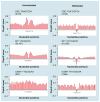CG methylation
- PMID: 23244310
- PMCID: PMC3566568
- DOI: 10.2217/epi.12.55
CG methylation
Abstract
A striking feature of mammalian genomes is the paucity of the CG dinucleotide. There are approximately 20,000 regions termed CpG islands where CGs cluster. This represents 5% of all CGs and 1% of the genome. CpG islands are typically unmethylated and are often promoters for housekeeping genes. The remaining 95% of CG dinucleotides are disposed throughout 99% of the genome and are typically methylated and found in half of all promoters. CG methylation facilitates binding of the C/EBP family of transcription factors, proteins critical for differentiation of many tissues. This allows these proteins to localize in the methylated CG poor regions of the genome where they may produce advantageous changes in gene expression at nearby or more distant regions of the genome. In this review, our growing understanding of the consequences of CG methylation will be surveyed.
Figures




Similar articles
-
CpG methylation recruits sequence specific transcription factors essential for tissue specific gene expression.Biochim Biophys Acta. 2012 Jul;1819(7):763-70. doi: 10.1016/j.bbagrm.2012.02.014. Epub 2012 Feb 23. Biochim Biophys Acta. 2012. PMID: 22387149 Free PMC article. Review.
-
Nucleosome dynamics and maintenance of epigenetic states of CpG islands.Phys Rev E. 2016 Jun;93(6):062417. doi: 10.1103/PhysRevE.93.062417. Epub 2016 Jun 28. Phys Rev E. 2016. PMID: 27415308
-
CpG methylation of half-CRE sequences creates C/EBPalpha binding sites that activate some tissue-specific genes.Proc Natl Acad Sci U S A. 2010 Nov 23;107(47):20311-6. doi: 10.1073/pnas.1008688107. Epub 2010 Nov 8. Proc Natl Acad Sci U S A. 2010. PMID: 21059933 Free PMC article.
-
Extreme HOT regions are CpG-dense promoters in C. elegans and humans.Genome Res. 2014 Jul;24(7):1138-46. doi: 10.1101/gr.161992.113. Epub 2014 Mar 20. Genome Res. 2014. PMID: 24653213 Free PMC article.
-
CpG islands: algorithms and applications in methylation studies.Biochem Biophys Res Commun. 2009 May 15;382(4):643-5. doi: 10.1016/j.bbrc.2009.03.076. Epub 2009 Mar 18. Biochem Biophys Res Commun. 2009. PMID: 19302978 Free PMC article. Review.
Cited by
-
The bZIP mutant CEBPB (V285A) has sequence specific DNA binding propensities similar to CREB1.Biochim Biophys Acta Gene Regul Mech. 2019 Apr;1862(4):486-492. doi: 10.1016/j.bbagrm.2019.02.002. Epub 2019 Feb 27. Biochim Biophys Acta Gene Regul Mech. 2019. PMID: 30825655 Free PMC article.
-
Functional annotation of noncoding mutations in cancer.Life Sci Alliance. 2021 Jul 19;4(9):e201900523. doi: 10.26508/lsa.201900523. Print 2021 Sep. Life Sci Alliance. 2021. PMID: 34282050 Free PMC article.
-
Epigenetic signature of Gleason score and prostate cancer recurrence after radical prostatectomy.Clin Epigenetics. 2016 Sep 15;8:97. doi: 10.1186/s13148-016-0260-z. eCollection 2016. Clin Epigenetics. 2016. PMID: 27651837 Free PMC article.
-
Global DNA methylation in rats´ liver is not affected by hypercholesterolemic diet.Physiol Res. 2020 Apr 30;69(2):347-252. doi: 10.33549/physiolres.934313. Epub 2020 Mar 23. Physiol Res. 2020. PMID: 32199015 Free PMC article.
-
Human DNA methylomes of neurodegenerative diseases show common epigenomic patterns.Transl Psychiatry. 2016 Jan 19;6(1):e718. doi: 10.1038/tp.2015.214. Transl Psychiatry. 2016. PMID: 26784972 Free PMC article.
References
-
- Bird AP, Southern EM. Use of restriction enzymes to study eukaryotic DNA methylation: I. The methylation pattern in ribosomal DNA from Xenopus laevis. J Mol Biol. 1978;118(1):27–47. - PubMed
-
- Adams RL, McKay EL, Craig LM, Burdon RH. Methylation of mosquito DNA. Biochim Biophys Acta. 1979;563(1):72–81. - PubMed
Publication types
MeSH terms
Substances
Grants and funding
LinkOut - more resources
Full Text Sources
